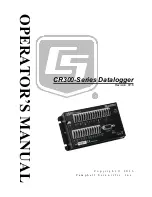
3-12
Basic DMM Operation
Model 2701 User’s Manual
AC voltage measurements and crest factor
The root-mean-square (RMS) value of any periodic voltage or current is equal to the value
of the DC voltage or current which delivers the same power to a resistance as the periodic
waveform does. Crest factor is the ratio of the peak value to the RMS value of a particular
waveform.
The crest factor of various waveforms is different, since the peak-to-RMS ratios are
variable. For example, the crest factor for a pulse waveform is related to the duty cycle, as
the duty cycle decreases, the crest factor increases. The RMS calculations and crest factor
(CF) for various waveforms are shown in Figure 3-4 and Figure 3-5.
The Model 2701 is an AC-coupled RMS meter. For an AC waveform with DC content, the
DC component is removed before the RMS is calculated. This affects the crest factor in
that the peak value of the waveform is different for a DC coupled waveform and an AC
coupled waveform. In an AC coupled waveform, the peak is measured from the original
DC average value not DC zero. For example, if a voltage pulse is measured on the AC
function of the Model 2701 with a peak voltage of V
P
and a low voltage of zero volts, the
AC coupled peak value will be calculated as follows:
AC
PEAK
= V
P
•
(1 - duty cycle)
Therefore the AC coupled crest factor will differ from the DC coupled waveform. The
RMS function will calculate the RMS value based on the pulsed waveform with an
average value of zero.
The reason to consider crest factor in accuracy of RMS measurements is because the
meter has a limited bandwidth. Theoretically, a sine wave can be measured with a finite
bandwidth because all of its energy is contained in a single frequency. Most other common
waveforms have a number of spectral components requiring an almost infinite bandwidth
above the fundamental frequency to measure the signal exactly. Because the amount of
energy contained in the harmonics becomes smaller with increasing frequency, very
accurate measurements can be made with a limited bandwidth meter, as long as enough
spectral components are captured to produce an acceptable error.
Crest factor is a relative measurement of the harmonic content of a particular waveform
and reflects the accuracy of the measurement.
For a rectangular pulse train, the higher the crest factor, the higher the harmonic content of
the waveform. This is not always true when making spectral comparisons between
different types of waveforms. A sine wave, for example, has a crest factor of 1.414 and a
square wave has a crest factor of 1. The sine wave has a single spectral component and the
square wave has components at all odd harmonics of the fundamental.
The Model 2701 RMS AC volts and AC amps accuracies are specified for sine waves of
different frequency ranges.
Additional error uncertainties are also specified for non-sinusoidal waveforms of specific
crest factors and frequencies. The Model 2701 has capabilities of measuring AC
waveforms of crest factors up to 5.
2701-900-01.book Page 12 Wednesday, August 3, 2011 9:43 AM
Summary of Contents for 2701
Page 344: ...12 CommonCommands 2701 900 01 book Page 1 Wednesday August 3 2011 9 43 AM...
Page 366: ...15 SCPIReferenceTables 2701 900 01 book Page 1 Wednesday August 3 2011 9 43 AM...
Page 393: ...A Specifications 2701 900 01 book Page 1 Wednesday August 3 2011 9 43 AM...
Page 399: ...B Model7700ConnectionGuide 2701 900 01 book Page 1 Wednesday August 3 2011 9 43 AM...
Page 410: ...C StatusandErrorMessages 2701 900 01 book Page 1 Wednesday August 3 2011 9 43 AM...
Page 417: ...D SignalProcessing SequenceandDataFlow 2701 900 01 book Page 1 Wednesday August 3 2011 9 43 AM...
Page 430: ...E MeasurementConsiderations 2701 900 01 book Page 1 Wednesday August 3 2011 9 43 AM...
Page 450: ...G KE2700InstrumentDriver Examples 2701 900 01 book Page 1 Wednesday August 3 2011 9 43 AM...
















































